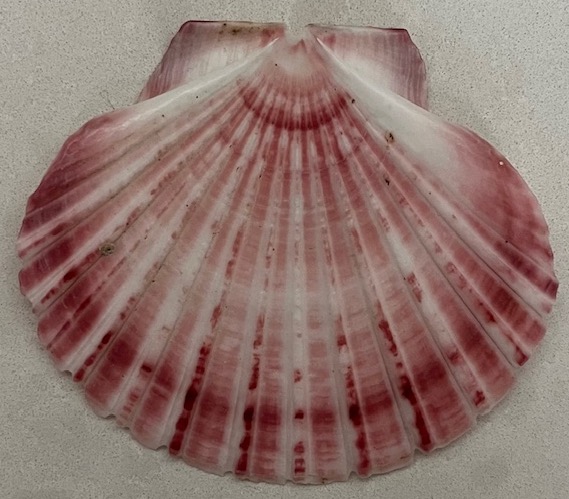‘A text, you just fire off. A letter is quiet and slow’: An Interview with Catharina Van Bohemen
By Ketaki Thorat
Edited by Annabel Wearring-Smith

‘Scallop shells are everywhere, and I found the shell I gave to my granddaughter on our beach at the tip of the North Island. It’s bigger and more beautiful than the one I took on the Camino, but finding it the day my granddaughter got the terrible news helped me write to her. I have always written letters. I never thought of sending her a text. When you write a letter, you think about it. A text, you just fire off. A letter is quiet and slow.’
The submission chosen by The Letters Page for the upcoming volume is a letter Catharina van Bohemen wrote to her fifteen-year-old granddaughter, who recently lost her best friend. I interviewed Catharina and discussed her account of walking the Camino de Santiago and its ongoing resonances, even though she walked it many years ago. We talked about coping with grief, mortality, creating connections with unfamiliar people, the invisible force of destiny, and a myriad of other topics.
In her letter, Catharina uses the pilgrim’s symbol of the Camino de Santiago, the scallop shell, to help her granddaughter understand the mystery of death. I asked Catharina about her scallop shell, the recurring motif of her letter.
‘A friend who knew the significance of the shell gave me my shell. You could go to St-Jean-Pied-de-Port at the foot of the Pyrenees and buy a shell, but I didn’t want a shell from a shop. I loved being given my own shell to attach to my pack. When I finally got to Compostela, I left it in a corner of the cathedral. Scallop shells are everywhere, and I found the shell I gave to my granddaughter on our beach at the tip of the North Island. It’s bigger and more beautiful than the one I took on the Camino, but finding it the day my granddaughter got the terrible news helped me write to her.’
‘I have always written letters. I never thought of sending her a text. When you write a letter, you think about it. A text, you just fire off. A letter is quiet and slow.’
Catharina’s view on letter writing really resonated with me. We went on to talk about Towards Compostela, her book about walking to Compostela. Catharina walked the Camino in 1998 – before Facebook and Instagram. She didn’t have a camera, but she took a journal, which she wrote in as she walked.
‘Before I left home, I asked my children and some of my close friends to write something in the journal. That was a fantastic thing to find as I walked – not just their words, but their handwriting. I met two Dutch men, on the second night of the Camino – at Roncesvalles – who also carried journals. We walked together or separately, but we would meet eventually, and when we did, we always sat down and wrote in our journals. Before they returned to the Netherlands, they wrote letters to me in my journal, and I wrote in theirs. My journal was a surge of words interspersed with poetry and my children’s writing. But Towards Compostela became a real collaboration with all the people I met along the way and my family.’
One of the things that really struck me about Catharina’s letter is how an invisible force influences our trajectory, weaving a tapestry of moments that define our lives. Catharina walked with strangers towards Compostela and developed a sense of community and belonging.
‘We couldn’t speak each other’s languages, but we were pilgrims together – we carried scallop shells. They were different shapes, sizes, and colours, but they connected us separately together. We were all walking in the same direction. We were walking towards something we could not necessarily express, but our shells united us.’
‘When you walk, you think all the time about where you’re coming from and where you are now. The present and the past become fused.’
Catharina asks her granddaughter to think of her friend by looking at the colours, ridges and grooves of the scallop shell and how they are “all converging towards an invisible point”. I was curious about how Catharina herself copes with death and the grief that comes with it.
‘I think getting older is hard. I go to a lot of funerals now. But as you grow older, a certain acceptance of life and death follows. You let go of things you thought were important. The Camino was a profound experience – certainly walking towards more than the arrival. I use the Camino as a metaphor for living and, perhaps, dying. I must learn to trust that everything unfolds as it should.’
After conversing with her, I found myself contemplating her pilgrimage as a metaphor for the journey of life. How curious that a sea of diverse individuals is connected by scallop shells dangling from backpacks. The journey: a path for every encounter with every stranger that holds the promise of a newfound connection.
If you would like to read Catharina’s letter, send us a letter of your own. Keep an eye out for our aerogramme if you have already sent us a letter in the past.
The Letters Page team are back in the office, and ready to read your real letters again. We publish stories, essays, poems, memoir, reportage, criticism, recipes, travelogue, and any hybrid forms, so long as they come to us in the form of a letter. We are looking for writers of all nationalities and ages, both established and emerging.
Your letter must be sent in the post, to :
The Letters Page, School of English, University of Nottingham, NG7 2RD, UK.
See our submissions page for more information.
To stay up to date on The Letters Page newsletter publication, subscribe here.